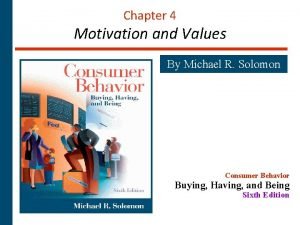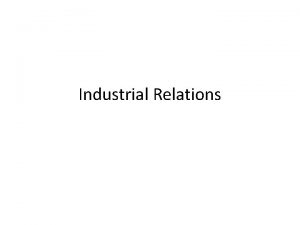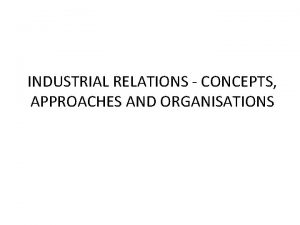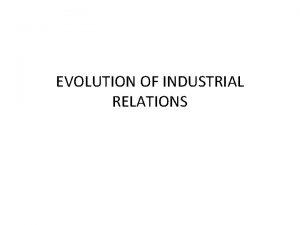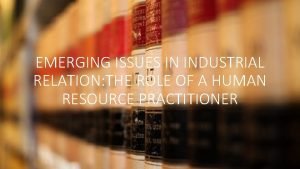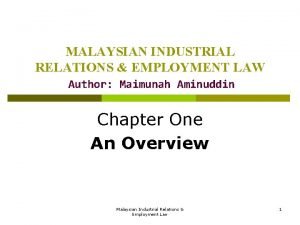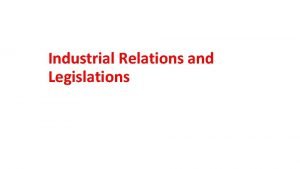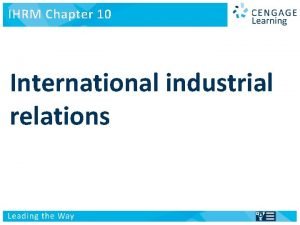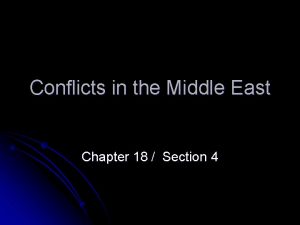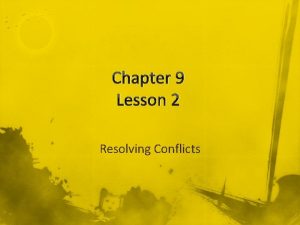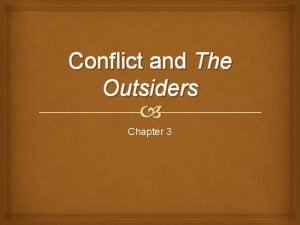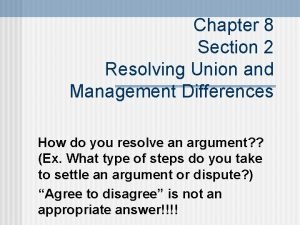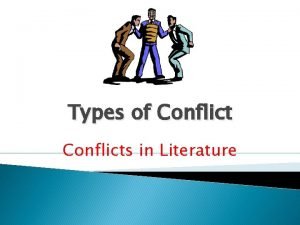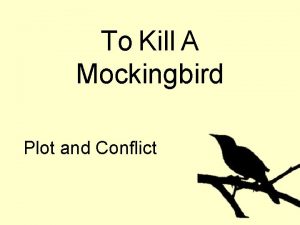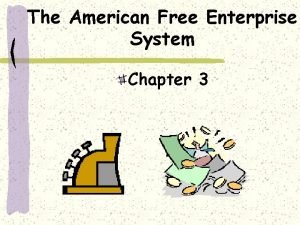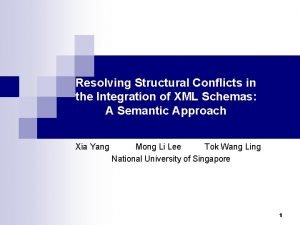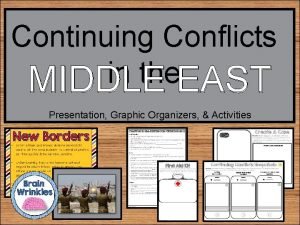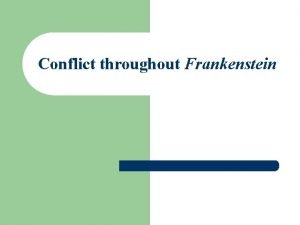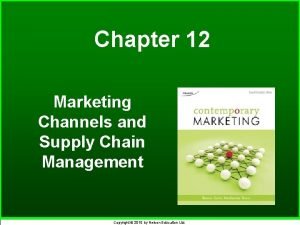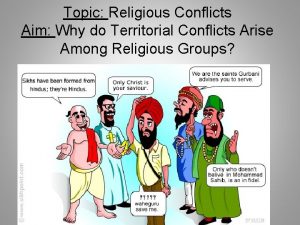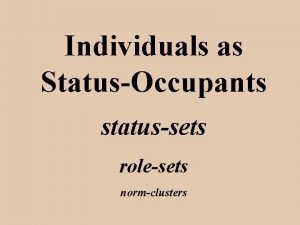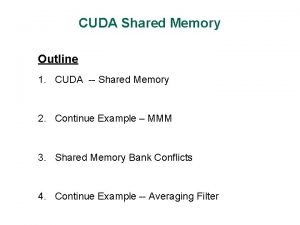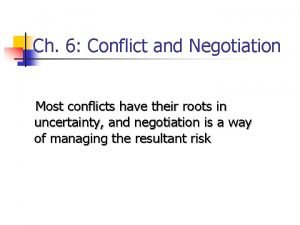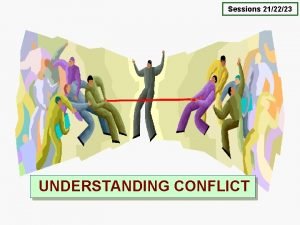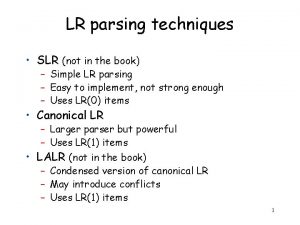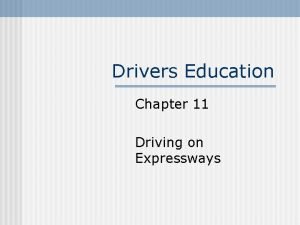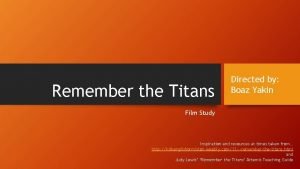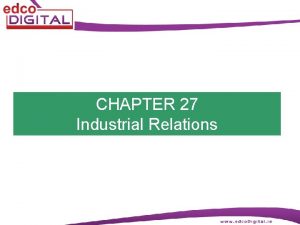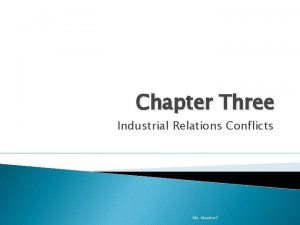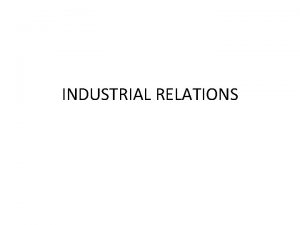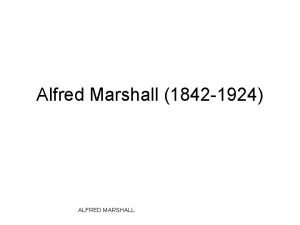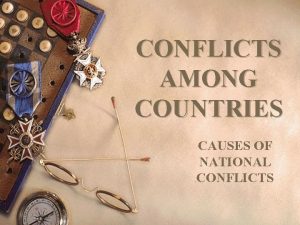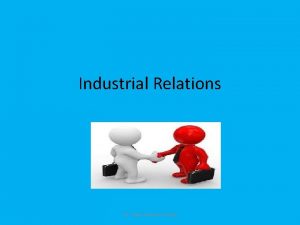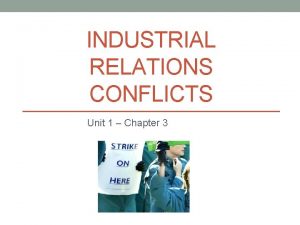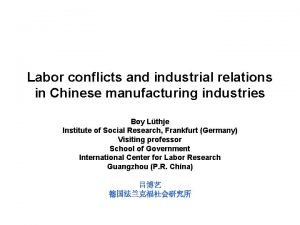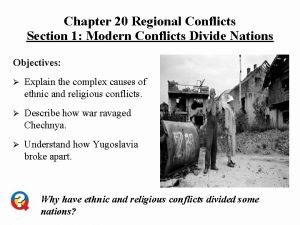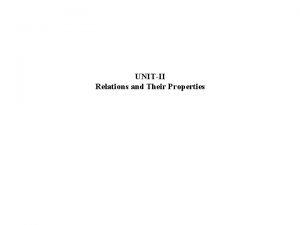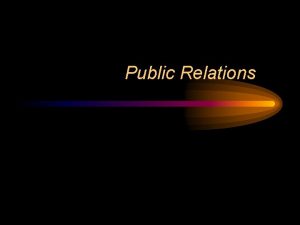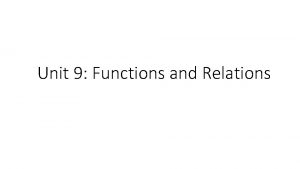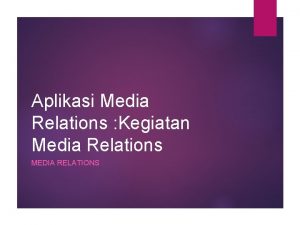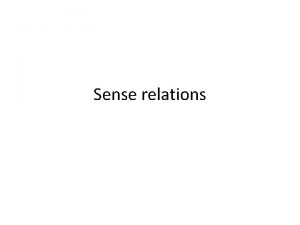Chapter Three Industrial Relations Conflicts Ms Marshall 1





















































- Slides: 53

Chapter Three Industrial Relations Conflicts Ms. Marshall

1. Industrial Relations 2. Conflict 3. Industrial Action You should know: 1. Definition Importance/benefits of good Industrial relations How to improve 2. Causes of Conflict 3. Types of Industrial Action Ms. Marshall

Importance of Good Industrial Relations � Definition: refers to the quality of the relations that exist between the managers and employees in an organisation. � Benefits: Ø 1. Attract best staff Ø 2. Good staff morale –> low absenteeism and labour turnover Ø 3. Increased Productivity Ø 4. Fewer industrial disputes Ø 5. More delegation and empowerment Ms. Marshall

How to Improve Industrial Relations � Paying good wages and providing good conditions of employment. � Having open communications between employers and employees. � Keeping promises and building up trust and respect between employers and employees. � Treating staff fairly, without discrimination. � Having a clear grievance procedure. Grievance procedures � Ensuring any dismissals are fair. should provide a simple, fair and quick method for resolving conflicts. Ms. Marshall

Causes of Conflict � 1. Pay and Conditions � 2. Redundancies and dismissals/suspensions � 3. Discrimination � 4. Demarcation: who does what? � Employees are allowed to ask for a pay rise for four different reasons: � 1. Comparability Claim � 2. Relativity Claim � 3. Productivity Claim � 4. Cost of Living Claim Ms. Marshall

Industrial Action � � Ø Ø Ø Industrial Action refers to the type of strike, or withdrawal of labour, that employees could engage in as a result of an industrial dispute. Official Strike � Ø Ø Ø Unofficial Strike Withdrawal of labour without secret ballot or minimum notice. Union does not recognise this type of strike. Illegal. Secret ballot held Majority vote yes Seven days minimum notice given to employer Employees withdraw labour and may receive strike pay from the union. As set out in the Legal Industrial Relations Act 1990 Ms. Marshall

Industrial Action � � All Out Strike: All the employees in the firm go on strike, even though only some are in dispute with the employer. ICTU permission is needed. Work-to-Rule: carrying out your basic job and nothing else. Slows down production. E. g. Irish nurses in 2007 � � Sit-in: A sit-in a form of direct action that involves one or more people non-violently occupying an area for a protest, often to promote political, social, or economic change. � Overtime Ban: Employees refuse to do any overtime. Slows down production. E. g. Passport Office in 2010. Token Stoppage: a show of strength by employees who temporarily stop working for a short period of time. Employees usually walk off the job during a particularly busy time, resulting in loss of revenue for the business. http: //www. youtube. com/watc h? v=2 r. V 3 evh 8 RAs e. g. Vita Cortex workers 2012 Ms. Marshall

Industrial Action � � Wildcat Strike: unofficial strike. Employees go on strike without any notice at all. They walk off the job, . e. g. Dublin Bus in 2009, drivers were unhappy with new schedules. Political Strikes: workers protesting against the government by stopping the work. This is illegal. Not fair to punish your employer. E. g. 1970’s USA Coal workers went on strike until the “Black Lung legislation” was passed. � � Sympathetic Strike: A group of employees not involved in the dispute goes on strike to show its support for the disputing workers. E. g. Jacobs workers went on sympathetic strike during the 1913 Lockout of Dublin’s Tram workers. Lockout: the employer excludes employees from the firm. E. g. In 1913, employers in Dublin engaged in a lockout of their workers- the tram drivers- employing blackleg labour from Britain and elsewhere in Ireland. Ms. Marshall

1913 Lockout � � � On 26 August 1913 the trams stopped running in Dublin. Striking conductors and drivers, members of the Irish Transport& General Workers’ Union, abandoned their vehicles. They had refused a demand from their employer, William Martin Murphy of the Dublin United Transport Company, to forswear union membership or face dismissal. The company then locked them out. Within a month, the charismatic union leader, James Larkin, had called out over 20, 000 workers across the city in sympathetic action. The resulting industrial dispute was the most severe in Ireland's history. Employers in Dublin employed blackleg labour from Britain and elsewhere in Ireland. http: //www. youtube. com/watch? v=J Np. XE 8 q_p 4 s Ms. Marshall

1913 � The strikers used mass pickets and intimidation against strike breakers and the Dublin Metropolitan Police in turn baton charged worker's rallies. The DMP's attack on a union rally on O'Connell Street in August 1913 caused the deaths of two workers and hundreds more were injured. In response, Larkin, his subordinate James Connolly, and ex-British Army Captain Jack White formed a worker's militia named the Irish Citizen Army to protect workers' demonstrations. � For seven months the lockout affected tens of thousands of Dublin's workers and their families, with Larkin portrayed as the villain by Murphy's three main newspapers, the Irish Independent, the Sunday Independent, and the Evening Herald. Ms. Marshall

1913 � � � The lockout eventually concluded in early 1914 when the calls for a sympathetic strike in Britain from Larkin and Connolly were rejected by the TUC. Most workers, many of whom were on the brink of starvation, went back to work and signed pledges not to join a union. The ITGWU was badly damaged by its defeat in the Lockout, and was further hit by the departure of Larkin to America in 1914 and the execution of James Connolly for his part in the nationalist Easter Rising in 1916. However, the union was re-built by William O'Brien and Thomas Johnson and 1919 its membership had surpassed that of 1913. Although the actions of the ITGWU and the smaller UBLU were unsuccessful in achieving substantially better pay and conditions for the workers, they marked a watershed in Irish labour history. The principle of union action and workers' solidarity had been firmly established; Ms. Marshall

Review Questions � 2010 HL Q 1 A (ii)Describe two types of industrial action a trade union can undertake as part of a trade dispute. (i. e. official types). � 2011 SQ Q 7: Outline two types of industrial action that employees could take in an attempt to get employers to meet their demands. � Sample � 1) Questions Define Industrial Relations? What are the benefits of good industrial relations? (20 marks). � 2) How can a firm promote good industrial relations? (15 marks) � 3) When is a strike considered legal? (10 marks). � 4) Illustrate two illegal types of strike (15 marks). Ms. Marshall

How to resolve a dispute? Non-Legislative 1. Negotiation 2. Conciliation 3. Arbitration Legislative 1. Laws 2. Legal Agencies Ms. Marshall

Non-Legislative Methods of Resolution Non Legislative methods means that they try to solve the problem themselves or with the help of a third party but without reference to the laws or legal bodies of Ireland. � A Non-legislative approach should be the first strategy in a conflict resolution process between employees and employer. 1. Negotiation A process of bargaining to try to reach a mutually acceptable solution to the conflict. Step One: Each side sets out their position Step Two: Discuss the issue Step Three: Compromise to reach a solution both will accept. When both sides agree on a deal this is called a collective agreement, but is not legally binding. Individual bargaining occurs when the employer negotiate individually with an employee. Collective bargaining occurs when the employer negotiates collectively with a group of employees, usually through a trade union representative. Ms. Marshall

Non-Legislative Methods of Resolution � 2. Conciliation. The conciliator (an independent third party) will speak to the employer and the employee separately and then together, highlighting the others point of view. The conciliator encourages the parties to settle the dispute through continued negotiation. � 3. Arbitration. With arbitration both sides in the disagreement agree beforehand to an independent third party’s intervention, investigation and judgement. They also agree before hand on whether the arbitration outcome should be binding or non-binding. Ms. Marshall

Negotiation - Trade Unions � Most employees would not feel comfortable bargaining alone with their employer. For this reason we have trade unions to represent us. � Trade unions are organisations that represent the views and interests of employees in matters concerning pay and conditions of employment. � Employees pay an annual subscription and vote in a shop steward as their local representative. � http: //www. unionconnect. ie/rights/1 discipline/ � http: //www. youtube. com/watch? v=Rfv 5_u. OCxk. M Ms. Marshall

Benefits of Trade Unions Better pay and working conditions: professional negotiators bargain on the behalf of the employee, getting him a better deal than he would get on his own. � Representation: the union will pay any legal bills and represent an employee in dispute with her employer. � National Voice: unions represent employees at the National Pay Agreements through the ICTU. � Protect Members Interests: unions use their strength to fight for employees jobs, redundancy payments and publicise their case. � Simplifies communication between management and employees on issues concerning pay and conditions. � http: //www. youtube. com/watch? v=2 te 59 Tm. QJCY&list=UU nb. Je. Nvzy. Iqh. TCm 6 Qhlz. CJw&index=1&feature=plcp � Ms. Marshall

Shop Steward � The elected union representative in the workplace. � Main functions: Ø Recruit new members to the union Ø Represent members in negotiation with management Ø Keep members up to date with information from head office Ø Inform head office of members concerns. Ms. Marshall

ICTU interest group representing almost all the trade unions in Ireland. � An � Functions of the ICTU Ø National Pay Agreements: acts as a negotiator on behalf of all the unions in dealing with the government, the EU and national employer organisations such as IBEC. Before the recession hit the ICTU helped negotiate Towards 2016, which has since been abandoned. Ms. Marshall

ICTU Gives permission for all out strikes. Ø Promotes the benefits of union membership among the general public. Makes submissions to the Minister of Finance. Ø Resolves disputes and disagreements between different unions. They will mediate to help solve the dispute. Ø Provides training, education and research services for unions and their members. Train shop stewards in negotiation skills, employees rights etc. Ø http: //www. youtube. com/watch? v=4 fe 1 ud 7 jlqk Ø Ms. Marshall

Review Questions � 2011 Q 1 HL Describe how conflict between an employer and employee could be resolved in a non legislative manner? (15 marks) � 2004 HL SQ Q 1: Distinguish between arbitration and conciliation. (10 marks). � 2010 OL: Outline two functions of a trade union. (10 marks). � Sample Questions � Outline two functions of the ICTU (10 marks) � Outline the duties of the shop steward Ms. Marshall

Irish Business and Employers Confederation IBEC � The employers’ interest group. � It lobbies for policies which further its members interests e. g. Reduced Employer’s PRSI. � It provides members to the Labour Relations Commission and the Labour Court. � It promotes enterprise and job creation in the economy. Ms. Marshall

Legislative Methods of Resolution The Laws 1. Industrial Relations Act 1990 2. Employment Equality Act, 1998 3. Unfair Dismissals Act, 1977/2007 The Agencies 1. The Labour Relations Commission 2. The Labour Court Ms. Marshall

Labour Relations Commission Functions of the LRC Labour Court Functions of the Labour Court LRC Rights Commissioner Ms. Marshall

Industrial Relations Act �A N B trade dispute is a “dispute between employers and employees in connection with the employment or non-employment or terms and conditions of the job. ” � Legitimate Pay & Conditions Causes of Conflict Redundancies or dismissals Right to join a Trade Union Demarcation Health & Safety Employment Policy Ms. Marshall

Legitimate Trade Dispute Pay & Conditions The most common reason. Includes rates of pay, overtime, holidays and terms of the contract. Redundancies & Dismissals The sacking of an employee for an unfair reason is grounds for a legitimate trade dispute. This includes constructive dismissal. Right to join a Trade Union The employer must not prevent the employee from joining a TU. The employer must recognise the unions right to negotiate on behalf of its members. Demarcation The employee should not be asked to perform duties that are not in the work contract or to perform menial tasks in comparison to qualifications. Marshall

Legitimate Employment Policy: The firm could recruit employees who are not qualified to do the job and this could cause conflict with the existing employees. Health & Safety: An employer who cuts costs by sacrificing employee welfare gives the employee grounds for a legitimate dispute, e. g. failure to supply safety equipment. Illegitimate Trade Disputes Enforcement of a closed shop agreement The dispute must not be as a result of a closed shop agreement which is a private deal allowing one trade union only in the workplace. Due to political issues The dispute is not recognised if it is related to political issues, e. g. protesting against government policies, your employer should not lose labour days. The running of the business Management are in charge of the running of the business and decision making process, employees can not strike over this. Marshall

Industrial Relations Act, 1990 � � � � 1. Trade Dispute as defined by the Industrial Relations Act 1990 is ‘any dispute between employers and workers, which is connected with the employment or non-employment or the terms or conditions of employment of any person’. The following issues may give rise to a legitimate trade dispute: dismissal, employment policy, demarcation, trade union membership, pay and conditions, health and safety at work. 2. Secret Ballots & Minimum Notice Under the provisions of the Industrial Relations Act 1990 no strike or other industrial action can take place without a secret ballot. All members are given a fair opportunity of voting. The act also provides that the union should not organise or participate in industrial action without a majority of votes having being cast in favour of industrial action. The union must make known to the members (entitled to vote) the results of a secret ballot as soon as practicable after the vote. One week’s notice of action must be given to the employer involved in a dispute. Ms. Marshall

Industrial Relations Act, 1990 � � � � 3. Official disputes unofficial disputes and Injunctions Official dispute is one where a union has received approval from workers in a secret ballot and is confirmed by ICTU. Unofficial disputes have no ICTU or union approval and workers receive no strike pay. According to the Industrial Relations Act 1990 organisers of unofficial disputes do not have legal protection against being sued by their employer. If trade union members engage in an illegal dispute then an employer can get an injunction (a court order restricting certain activities) against the workers involved. 4. Picketing Primary picketing. According to the Industrial Relations Act 1990 it is lawful for workers to picket peacefully at a place where their employer works or carries on business provided the picketing is for the purpose of peacefully communicating information. Secondary picketing. The act provides that secondary picketing (i. e. picketing of an employer other than the primary employer involved in the dispute) is lawful only in situations where it is reasonable for those workers picketing to believe that the second employer was acting to frustrate the industrial action by directly assisting their employer. Ms. Marshall

Industrial Relations Act, 1990 � 5. Immunity � The Industrial Relations Act 1990 states the trade unions and workers are immune from legal action/prosecution for damages or losses suffered by the employer as a result of a trade dispute. This means an employer cannot sue a trade union and its members for losses suffered as a result of a strike (provided it is an official trade dispute) and a secret ballot (members must have voted in favour of the industrial action) was held by the trade union before the strike action. 6. It set up the LRC 7. This Act reorganised the Labour Court Ms. Marshall

Industrial Relations Act –The Role of the LRC The role of the Labour Relations Commission (LRC) is to have general responsibility for promoting the improvement of industrial relations through the provision of a range of services to employers, trade unions and employees. These include: � 1. Conciliation service � 2. Drawing up codes of practice for industrial disputes � 3. Industrial relations advisory service � 4. Rights Commissioner service � 5. Appointment of equality officers. � 6. Researching and monitoring developments in the area of industrial relations. � www. lrc. ie � Ms. Marshall

Functions of the LRC � 1. Conciliation Service: the LRC can appoint an Industrial Relations Officer to try and resolve the dispute. A settlement occurs when both parties come to an agreement. The recommendation of the IRO is not legally binding. Evaluation: However, this is still effective as 80% of all cases are resolved at this point. The decision can be appealed to the Labour Court. Ms. Marshall

Functions of the LRC � 2. Codes of Practice are drawn up: these are accepted procedures that should be followed in the event of a workplace dispute. The aim is to minimise industrial relations problems in an industry. Evaluation: They are not legally enforceable but if broken this is taken into consideration by the LRC when settling a dispute. � 3. Advisory Service: The LRC also provides an industrial relations advisory service to help employers and employees build up good industrial relations practice. Evaluation: This is effective because it is free and professional advice. Ms. Marshall

LRC/Rights Commissioner � 4. Rights Commissioner: investigates dispute involving one person or a small group of workers. They investigate disputes involving unfair dismissal, maternity leave, suspension and disciplinary issues. � The RC makes recommendations which are not legally binding. Either party may appeal to the Labour Court. � Evaluation: The RC is effective because the hearing is private and both parties may bring witnesses. Marshall

Functions of the LRC � 5. Equality Officer Service: the LRC provides equality officers to investigate equality issues. They hold informal hearings and have the right to obtain relevant information. They issue a recommendation which may be appealed to the Labour Court. � 6. Research and Monitor: the LRC monitor current developments in industrial relations. This means that it tries to develop new ways of solving disputes that arise in industrial relations. This is a good thing because they can come up with solutions to potential problems. Ms. Marshall

Industrial Relations Act -Labour Court � � � � IF the LRC fails to resolve a dispute, it can be referred to the Labour Court, the court of last resort for industrial relations disputes. NB It provides an arbitration service by listening to both sides in a dispute before recommending a solution. The Labour Court 1. Consists of representatives from the employers, the TU, and an independent chairperson. 2. Recommends a solution. Both sides may agree in advance to accept this solution, making it binding arbitration. 3. Registers Industrial relations agreements made between employers and unions. Once registered, these agreements become legally binding. 4. Establishes Joint Labour Committees (JLCs) as a forum for negotiating minimum pay and conditions in industries where workers do not have union protection. www. labourcourt. ie Ms. Marshall

Review Questions- Industrial Relations Act 1990 Mocks 2012: Evaluate the role of the LRC in creating and maintaining industrial relations harmony in the workplace. In your answer refer to the role of the Rights Commissioner (25 marks). � 2010 Q 1: Outline the impact on trade unions of the main provisions of the Industrial Relations Act 1990. (20 marks). � 2008 Q 1: Evaluate the role of the Labour Court in dealing with industrial disputes. (20 marks). � 2007 Q 1: Under the terms of the Industrial Relations Act 1990 (i) define a legitimate trade dispute and (ii) explain the role of the Labour Relations Commission. (20 marks). � 2004 Q 1: Under the terms of the Industrial Relations Act 1990 explain the reasons for legitimate trade disputes (20 marks). � Ms. Marshall

Unfair Dismissals Acts 1977/2007 Key Points 1. Reasons for Fair Dismissal 2. Employers Responsibilities 3. Reasons for Unfair Dismissal 4. Redress 5. Employment Appeals Tribunal Ms. Marshall

Unfair Dismissals Acts 1977/2007 Dismissal means to be sacked from a job due to incompetence, dishonesty or breach of company discipline. The Unfair Dismissals Acts are the laws preventing employees from being dismissed from their job for unfair reasons. Reasons for Fair Dismissal � 1. Incompetent or incapable of doing the job � 2. Unacceptable conduct (e. g. drunk at work, stealing). � 3. Redundancy: Voluntary or compulsory � 4. The employer followed proper procedures. � 5. Not qualified � NB the onus is on the employer to prove that the dismissal was fair. � Ms. Marshall

Unfair Dismissals � The employer must show: � He followed the proper procedure (e. g. verbal warning, written warning, investigation of allegations, employee representation at investigation). � He has proof that their conduct was unacceptable/ they were incompetent/ the job was redundant. � He did not engage in constructive dismissal. This means making working conditions for an employee so difficult that the employee is forced to leave his or her job (e. g. excessive workload, harassment). Ms. Marshall

These Acts mostly apply to those working longer than 1 year, however if you are dismissed for these reasons you are protected regardless dismissed because of: of the time served. Unfair Dismissals � The employee is � Pregnancy (inc. maternity leave) � Union Activities � Beliefs – religious or political � Race – colour or ethnic background � Suing Boss – or a witness in a case against the employer � Traveller � Sexual orientation – homosexual, lesbian, heterosexual or bisexual. Ms. Marshall

Unfair Dismissals � Before being dismissed you have the right to: � Know the reason for dismissal. � To reply to those reasons � To have a fair hearing, accompanied by a representative. Redress for Unfair Dismissals � NB 1. Re-instatement 2. Re-engagement 3. Compensation Ms. Marshall

Unfair Dismissals Acts Employment Appeals Tribunal � The EAT is the State body responsible for ensuring that firms obey the Unfair Dismissals Acts 1977 to 2007. � The EAT investigates and resolves the disputes between workers and employers concerning sacking and redundancies. � It is informal, quick and inexpensive. � They hear the case and make a judgement on it. � Its decisions are legally binding. Ms. Marshall

Evaluation of the Acts �I think the Unfair Dismissals Acts are effective at protecting workers because… � 1. Workers cannot lose their jobs because employers do not like them. They must have a legitimate reason and the onus is on the employer to prove that reason. � 2. A worker who is unfairly dismissed can win her job back or receive financial compensation. � 3. Employees are protected against bosses who would try to make them leave by making their jobs miserable. � 4. The EAT have real power as their decisions are legally binding. Ms. Marshall

Review Questions – Unfair Dismissals Acts 1977/2007 � 2012 Q 1: Outline the procedure an employer should follow under the Unfair Dismissals Act of 1977 -2007, before dismissing an employee. (20 marks). � 2010 SQ: Outline three grounds for fair dismissal under the terms of Unfair Dismissals Acts 1977/2007. (10 marks). � 2006 Q 1: Describe the different types of redress that are available to employees for unfair dismissal. Illustrate your answer with appropriate examples. � Sample Questions � 1. Outline three reasons for unfair dismissal (15 marks). � 2. Evaluate the effectiveness of the EAT (10 marks). Ms. Marshall

Employment Equality Act 1998 1 5 main provisions 2 Definition of Discrimination 3 Determines when it is illegal to discriminate 4 Equal pay for equal work 5 Positive discrimination is allowed Set up the Equality Authority & the Director of the Equality Tribunal Ms. Marshall

Employment Equality Act 1998 � � � 1. Discrimination is described as the treatment of a person in a less favourable way than another person is, has been or would be treated in a comparable situation on any of the nine grounds. Grounds under which discrimination is outlawed Gender Marital Status Family Status Sexual Orientation Religion Age Disability Race Member of Traveller Community 2. It is illegal to discriminate when hiring, training, promoting, advertising for employees and in the conditions of employment. NB VERY IMPORTANT SLIDE Ms. Marshall

Employment Equality Act 1998 � 3. Equal Pay for Equal work is a legal requirement. Employees doing the same, similar work of equal value must be paid the same. � 4. Positive Discrimination is allowed to promote equal opportunities. This means that the employer can take steps to help the nine categories of employees to full equality in the workplace. Ms. Marshall

Employment Equality Act 1998 The Equality Authority is the State agency responsible for ensuring that businesses do not break equality laws. Its main aims are � To eliminate discrimination in the workplace � To promote equal opportunities at work. 1. 2. 3. 4. Monitor the operation of all equality legislation. Advise employers, employees and customers of the legal rights and responsibilities in this area. Assist people with equality complaints. If a complaint appears to be valid, the Equality Authority may refer the case to the DEI for a full investigation. Draw up codes of practice to help eliminate discrimination and promote equal opportunities at work. Ms. Marshall

Employment Equality Act 1998 � � � � 2009: Evaluate the role of the Director of the Equality Tribunal in resolving complaints of discrimination in the workplace. Director of Equality Investigations Complaints of discrimination/breaches of equality legislation may be reported to and investigated by the Director of Equality Investigation/Director of Equality Tribunal, who issues a decision. The DEI may elect to either: 1. Refer the complaint to an Equality Mediator, who facilities both parties to reach a mutually acceptable agreement. (CONCILIATION) OR 2. Refer the complaint for consideration and decision to an Equality Officer. While the decision of the Equality Officer in relation to the complaint is binding, it may be appealed by either party to the Labour Court. The office of the DEI is effective as both the Equality Office and the Equality Mediator assist in achieving a resolution to complaints of discrimination. (continued on next slide)… Ms. Marshall

Evaluation of DET…continued from 2009 question… Equality Officers can order compensation and/or a specified course of action. � Decisions are binding and enforceable through the Circuit Court. All decisions may be appealed to the Labour Court within 42 days. In equal pay cases, the DEI may order equal pay and arrears in respect of a period not exceeding 3 years preceding the reference of the case. � Services are accessible to all and are free of charge. Complainants are not required to be formally represented. � Decisions provide a strong foundation of case law to assist in the elimination of unlawful discrimination/ power to direct that practices shown to be discriminatory should cease. � Decisions are made available to the widest possible audience to foster an awareness of what constitutes discrimination and to help prevent future discrimination. � Ms. Marshall

Employment Equality Act 1998 Evaluation “I think this Act is effective because…” 1. All workers must be treated equally regardless of beliefs, colour, creed, sexuality or personal circumstances. 2. It sets out the categories where discrimination has historically occurred. Positive discrimination attempts to right the wrongs done in the past. 3. The DET is a government backed official who will fight for the worker and whose ruling must be obeyed. Ms. Marshall

Review Questions – Employment Equality Act 1998 � 2009/2003: Explain the term “Employment discrimination” as set out in the Employment Equality Act 1998. (i. e. definition and when it applies) � 2009/2008/2003: List five distinct grounds on which discrimination is outlawed under the Act. (10 marks) � 2009/2004(ii) Evaluate the role of the Director of the Equality Tribunal. (20 marks) � Ms. Marshall
 Motivational conflict in consumer behavior
Motivational conflict in consumer behavior Employee relations in public relations
Employee relations in public relations Concept of industrial relations
Concept of industrial relations Relations
Relations Dunlop system approach
Dunlop system approach Evolution of industrial relation
Evolution of industrial relation Introduction to industrial relations
Introduction to industrial relations Key players in malaysian industrial relations
Key players in malaysian industrial relations Importance of industrial relations
Importance of industrial relations Approaches to industrial relations
Approaches to industrial relations International industrial relations in ihrm
International industrial relations in ihrm Theory of industrial relations
Theory of industrial relations Chapter 18 section 4 conflicts in the middle east
Chapter 18 section 4 conflicts in the middle east Chapter 9 resolving conflicts and preventing violence
Chapter 9 resolving conflicts and preventing violence Chapter 9 lesson 2 resolving conflicts
Chapter 9 lesson 2 resolving conflicts Brainpop seminole wars
Brainpop seminole wars Chapter 9 resolving conflicts and preventing violence
Chapter 9 resolving conflicts and preventing violence Conflicts in the outsiders chapter 1
Conflicts in the outsiders chapter 1 Modified union shop definition
Modified union shop definition External conflict literary definition
External conflict literary definition To kill a mockingbird bildungsroman
To kill a mockingbird bildungsroman To kill a mockingbird plot
To kill a mockingbird plot Modified free enterprise economy
Modified free enterprise economy Structural conflicts
Structural conflicts Conflict in fahrenheit 451
Conflict in fahrenheit 451 Conflicts in the middle east comprehension check
Conflicts in the middle east comprehension check What is the conflict of frankenstein
What is the conflict of frankenstein Horizontal conflicts
Horizontal conflicts Channel conflicts
Channel conflicts What is the conflict in animal farm
What is the conflict in animal farm What is the conflict in the crucible act 2
What is the conflict in the crucible act 2 Is man vs self internal or external
Is man vs self internal or external Conflict in wuthering heights
Conflict in wuthering heights Person vs society example
Person vs society example Why do territorial conflicts arise among religious groups
Why do territorial conflicts arise among religious groups The old man and the sea criticism
The old man and the sea criticism The seven rooms in the masque of the red death
The seven rooms in the masque of the red death Conflict of the call of the wild
Conflict of the call of the wild Exposition of freak the mighty
Exposition of freak the mighty Name two ways to prevent conflicts from building
Name two ways to prevent conflicts from building Stakeholder gcse business
Stakeholder gcse business Conflicts in cinderella
Conflicts in cinderella The lady or the tiger analysis
The lady or the tiger analysis The lady or the tiger conflict
The lady or the tiger conflict Status conflict
Status conflict Shared memory cuda
Shared memory cuda Most conflicts have their roots in
Most conflicts have their roots in Stages of conflict
Stages of conflict Slr
Slr What are three possible exiting problems
What are three possible exiting problems Biblical allusion in the crucible
Biblical allusion in the crucible Boaz yakin remember the titans
Boaz yakin remember the titans Pinard maneuver
Pinard maneuver Marshall plan significance
Marshall plan significance
